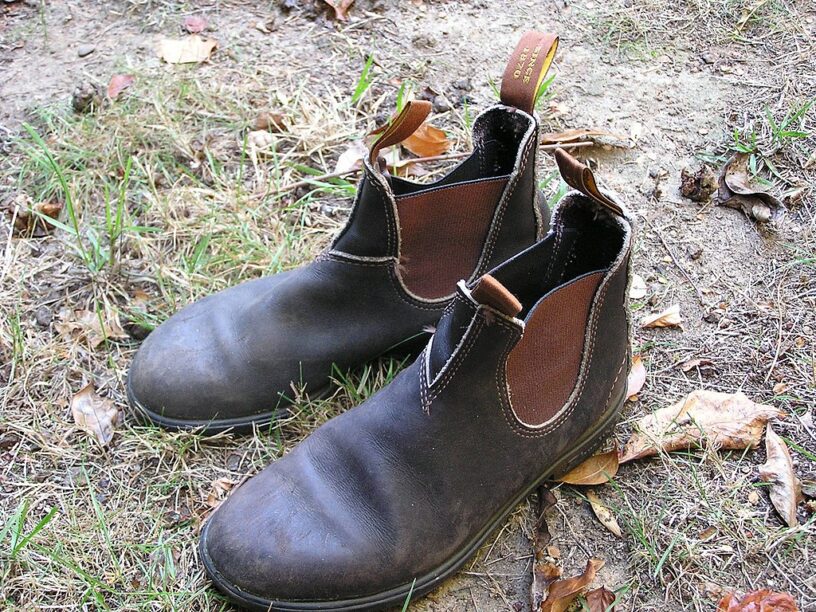15 Fun Facts About Shoes
Since the beginning of time, shoes have been an important part of everyday life, providing both functional and fashionable needs. Since culture, technology, and fashion have changed throughout history, shoes have also evolved in terms of look, design, and purpose. In this article, we will take a look at 15 fun facts about shoes, facts that we’re pretty sure you didn’t know about.
These facts will cover everything from the oldest to the most expensive shoes, the history of high heels, to the traditions surrounding the wearing of shoes in many countries. Whether you’re a shoe enthusiast or you’re just interested in the past and culture of shoes these facts will knock your socks off.
1. Barleycorn were used to measure shoe sizes

barley grains by Davidbena from Wikimedia Commons
In the past, the size of shoes was measured in barleycorns, an ancient unit of measurement. Three barleycorns were equal to one inch and one-third of an inch, respectively. The so-called “barleycorn system,” which was used widely up until the 19th century, was developed in England in the 14th century.
A cobbler would measure the length of a customer’s foot in barleycorns to establish the correct shoe size, and would then use a conversion table to do so. This technique had certain shortcomings because it failed to take differences in foot width and arch length into consideration. But the barleycorn system survived for a long time and is still a fascinating aspect of shoe history.
2. Heels were originally made for men

Man in Armor by Edwin Lord Weeks from Wikimedia Commons
It might surprise you to learn that high heels were first designed for men rather than ladies. When riding horses in the 16th century, Persian warriors wore boots with heels to help them stay in the stirrups. The style quickly spread to Europe, where powerful men started wearing heels as a sign of their riches and rank.
Men with heels appeared to be towering over other people and exuded power and superiority. Women didn’t start wearing heels until the 17th century because they too wanted to portray rank and grace. As fashion trends changed, heels changed in height and style, becoming more and more associated with femininity.
3. Greek actors wore platform-heeled shoes on stage
Platform shoes were popular among Greek performers in the fifth century BC because they gave them a powerful presence on stage. The kothorni platforms, which might be several inches high, were made from wood or cork. The height of the platform varied based on the role played by the actor, with gods and heroes having the highest platforms.
In addition to giving the actors a taller appearance, the kothorni also helped them project their speech and movements to the audience. Platform shoes were eventually used in theatre in other cultures, such as Rome and mediaeval Europe, where artists continued to do so in to bring drama and grandeur to their performances.
4. The first elastic-sided boots were made for Queen Victoria
The original Chelsea boots, also known as elastic-sided boots, were created especially for Queen Victoria in the middle of the 19th century. The Queen needed a practical, comfortable boot that could be put on and taken off easily because she was known for her passion for riding horses.
Innovative side panels on the boot allow for a secure fit without the use of laces or buckles. The Queen was so pleased with the boots that she purchased several other pairs in various colours, starting a craze among the affluent ladies of the day. The Chelsea boot is still a common and practical style that is admired for its cosiness, wearability, and timeless form. It is worn by both men and women today.
5. The largest high-heeled shoe was created by Jill Martin and fashion brand Kenneth Cole
2014 saw the creation of the biggest high-heeled shoe in the world thanks to a partnership between television personality and fashion consultant Jill Martin and clothing company Kenneth Cole. The 6 metres (20 feet) long, 2.5 metres (8 feet) broad, and 1.8 metres (6 feet) tall shoe was made as part of an initiative to raise money for amfAR, The Fund for AIDS Research.
Thousands of glistening gems are embedded into the traditional stiletto form of the shoe. It took a group of accomplished artisans and craftsmen more than two months to build the shoe from scratch. The sneaker made its premiere at the charity event and then continued on tour, stopping at various places around the world while igniting wonder and appreciation.
6. Jimmy Choo created his first shoe at 11

Jimmy Choo by Lawrence Wang from Wikimedia Commons
Jimmy Choo is a well-known fashion designer who is most known for his stunning shoe creations. He allegedly made his first pair of shoes when he was just 11 years old. Choo, who was born in Malaysia, grew up in a family of shoemakers, where he studied the trade from his father. To further his skills he went to London where he learned how to make better shoes and started his own high-end shoe company. His work is held in high regard by celebrities and loyal fashion fans.
7. Wedges were invented by Ferragamo

Salvatore Ferragamo by Sheila Thomson from Wikimedia Commons
It is known that designer Salvatore Ferragamo invented the wedge shoe in the 1930s. Though more people were used to high heels, the price to pay was a lot of discomforts because high heels are generally not easy to walk in, the wedge changed this for most people. Unlike the heel, Ferragamo created a shoe with a heel that covered the full foot to offer a more stable and comfortable basis.
8. The iconic red soles of Louboutin shoes were inspired by Andy Warhol drawing
Contrary to popular belief, an Andy Warhol drawing was not the source of the iconic red soles of Louboutin shoes. However, it is said that in the early 1990s, shoe designer Christian Louboutin was working on a new design when he realised that something was missing.
He saw his assistant painting her nails a vibrant shade of red and knew right away it was the colour he needed for the soles. The crimson sole quickly became recognised as a trademark of the Louboutin brand to provide a striking contrast to the style of the shoe.
9. Dr. Marten boots were meant to be reliable work boots
Finding men’s shoes has never been the easiest task and that is where Dr. Marten’s boots came in, his work was to create reliable footwear for men. He created the first paid or air-cushioned boots in 1945 that helped to treat foot injuries. The boots were created and produced by a British shoe business which quickly won the favour of many men who needed comfortable shoes. Dr. Marten’s shoes also had thick rubber bottoms that provided great grip, protection and support that most men needed especially during laborious tasks.
10. The Ruby Red slippers from The Wizard of Oz are the most expensive shoes sold at an auction
The ruby red shoes from “The Wizard of Oz” are a cultural icon that has fascinated people for decades. They were modified from silver in L. Frank Baum’s book to ruby red for the iconic 1939 film adaption. The shoes, which were made of red sequins, were so well-liked that they were often taken from the MGM Studios.
Since then, they have come to represent both magic and glitz, and it plays a big part in pop culture. One of the most expensive pieces of movie memorabilia ever sold, the slippers’ iconic position was confirmed when they went up for auction in 2000 and brought in a record-breaking $660,000.
11. One of the strangest shoes invented is the rat shoe
The rat shoe is unquestionably one of the weirdest shoe designs in history. As the name implies, this shoe is designed to draw rats thanks to a little compartment that is integrated into the heel and is filled with food. Rat populations were beginning to pose a severe concern in cities, so the rat shoe was created to control them. James Henry Atkinson, a British inventor, developed the shoe in the early 1900s, and despite its lack of economic success, it is still an intriguing and unusual invention.
12. The oldest shoes known are sagebrush bark
The earliest known shoe date to roughly 8,000 BC and are made of sagebrush bark. These shoes were made by the local indigenous people and were discovered in the Fort Rock Cave in Oregon, USA. The sagebrush plant’s bark was woven into the shape of a rudimentary shoe with a flat sole and a pointed toe. These shoes helped the wearer’s feet stay warm on chilly surfaces and protected their feet from sharp objects.
13. The word “stiletto” meant “little dagger”
We associate stilettos with power, sexiness and powerful women. However, what you probably didn’t know is that “stiletto” means little dagger and true to their name stilettos are long, narrow heels that look like daggers and are absolutely horrifying to walk in (for some of us).
They’ve been popular since the 1950s and are associated with sex appeal, sophistication and glamour. They make women look taller and slender and are known for their ability to make their legs look taller. Anyone who wants to look fashionable is prone to wear these shoes even though they are not the most comfortable choice for footwear.
14. Flip-flops originally appeared in Egypt
Flip-flops have been around for a very long time, and they actually originated in ancient Egypt, despite the fact that they may appear to be a new invention. Flip-flops were invented in the ancient world, and both men and women used papyrus-leaf-made footwear. Flip-flops evolved as time passed and were created from a range of materials, such as rubber and leather. Nowadays, many individuals all around the world, especially in warm areas, like to wear flip-flops as footwear. Lightweight and simple to put on and take off, they offer a relaxed and comfortable solution for daily wear.
15. Scientists suggest leaving shoes outside to avoid tracking in pathogenic chemicals
To prevent bringing harmful substances into homes, scientists advise leaving shoes outside. Pesticides, lead, and other dangerous chemicals are just a few of the substances that shoes can pick up, and they could endanger people’s health. According to studies, removing shoes at the door or leaving them outside can drastically cut down on the number of harmful toxins that are tracked inside dwellings. Removing shoes at the entrance can help keep floors and carpets clean and limit the quantity of dirt and dust that is brought inside, in addition to safeguarding human health.
I have to thank whoever saw the need for shoes and created them all those many years ago. There are still many areas in the world where people walk barefoot and I can tell you for a fact that our precious feet belong to our shoes, we avoid cuts, jiggers and of course, our skin is protected.
Planning a trip to Paris ? Get ready !
These are Amazon’s best-selling travel products that you may need for coming to Paris.
Bookstore
- The best travel book : Rick Steves – Paris 2023 – Learn more here
- Fodor’s Paris 2024 – Learn more here
Travel Gear
- Venture Pal Lightweight Backpack – Learn more here
- Samsonite Winfield 2 28″ Luggage – Learn more here
- Swig Savvy’s Stainless Steel Insulated Water Bottle – Learn more here
Check Amazon’s best-seller list for the most popular travel accessories. We sometimes read this list just to find out what new travel products people are buying.











